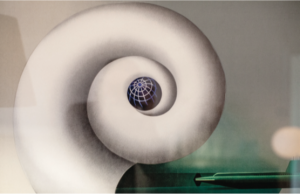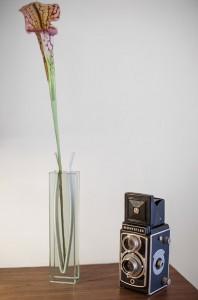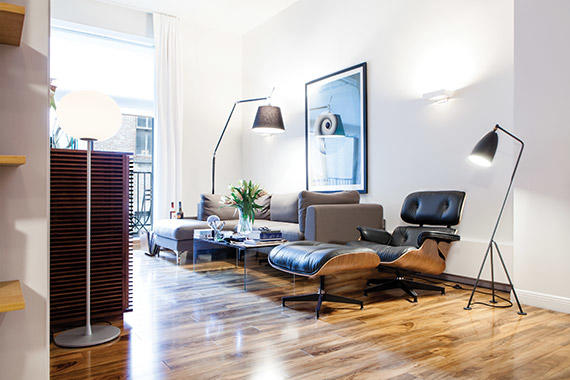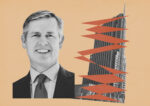Trending
Vertical ambition
Best-selling novelist Douglas Kennedy returns to his native Manhattan
Feet propped and laptop in its eponymous position, bestselling author Douglas Kennedy grinds out his daily 500 words from a low-sitting Eames chair in the center of his Fifth Avenue apartment. For notes, he is armed with a vintage Italian fountain pen by Omas and a black Moleskine notebook. When it comes to water, it’s sparkling.
Kennedy, 59, has sold some 13 million books worldwide, been translated into 22 languages and honored with the French equivalent of a knighthood, the Chevalier de l’Ordre des Arts et des Lettres. He’s published 14 books in all, one every two years. And after spending more than three decades abroad, Kennedy is once again calling his native Manhattan his HQ.
The hard, heroin addicted, often impecunious New York City Kennedy left as a young man in the late 1970s bares little resemblance to the gated community of global wealth to which he has returned. “I grew up in the East Village, when there was still a middle class in the city,” Kennedy said. “But when I got into Collegiate School [on the Upper West Side], my parents moved us to West 77th Street between Central Park West and Columbus. Back then, in the mid-1960s, it was a very different neighborhood. Columbus Avenue was a no-go area at night. We had a welfare hotel on the corner next to a Stanford White apartment building. It was an area of immigrants and intellectuals.”

Photography by STUDIO SCRIVO
But despite all of its recent gestures towards plutocracy, Kennedy stills sees New York as a culturally diverse, artistically ebullient and utterly personal city, compared to his previous home base, London. “My New York is a place of friends and of theaters, from the cinematheque at MoMA and Carnegie Hall to the Public Theater and the Bushwick Star,” Kennedy said.
“And frankly,” he adds, “what I appreciated coming back was the fact that the dynamic here is happier. New York is a happier place than London.”
Today, Kennedy calls the unlikely corner of Fifth Avenue and 35th Street home, just steps away from the Empire State Building. However, he continues to spend the equivalent of several months a year elsewhere, keeping pieds-à-terre in London, Paris, Berlin, Maine and Montreal, where his wife resides.
“When I returned to New York, I told my realtor that I was more interested in space than location,” he said. “She showed me this place, and, in her very New York City way, said, ‘The apartment’s a dump, but it’s got great bones!’”
Kennedy agreed. “It was in an absolutely catastrophic state,” he recalls. “There was popcorn on the [dropped] ceiling and it had an old dismal bathroom and kitchen. But the space, the ceiling height and the Edward Hopper-esque view from the terrace spoke to me immediately.”
He picked up the one-bedroom in the 1920s-department-store-turned-doorman-co-op-building in 2013. Straightaway, he got to work giving the apartment a makeover. “I love renovating,” Kennedy said. “It is a lot of work, but it’s interesting to create something beautiful out of something tired.”

Photography by STUDIO SCRIVO
To suit his clean, modern but “not minimalist,” aesthetic, Kennedy orchestrated a ruthless renovation, ordering the walls, ceiling and fixtures stripped and rebuilt to maximize his space. To act as advisors on the complex project, he enlisted the aid of his close friend Kingdon Knowles, the founder of Contemporary Design, a Manhattan-based home remodeling firm, and architect and designer Ellen Martin.
The team added square footage by knocking out a wall that jutted into what is now the dining area. In the kitchen, a carefully chosen shade of matte, dark gray cabinetry was selected to compliment the sheen of the stainless steel appliances. In the bathroom, they installed a glass-box shower that leaves nothing to the imagination. In the bedroom, every personal effect was given a home — no overflowing closets here.
“The devil is in the details,” he said. “You have to think in a micro as well as a macro way.”
Indeed, a spin through his apartment reveals few, meticulously selected objects: a framed mid-century advertisement for a nuclear submarine, a 1920s camera, a signed Leroy Neiman poster, Swedish architect and designer Greta Magnusson Grossman’s iconic Grasshopper Floor Lamp and a first edition copy of Hemingway’s “A Farewell to Arms.” And despite his years of extensive globe trekking, Kennedy’s Manhattan home is conspicuously trinket-free. His space, like his disposition, is warm but highly controlled.
As a young man, Kennedy decamped from his parents’ Upper West Side apartment for a then-turbulent Dublin — he had already grown attached to the city after spending a semester there at Trinity College. With the prose of Graham Greene under his sails, he longed to escape the mundane, upper-middle-class life of a lawyer that his parents hoped he would pursue.

Photography by STUDIO SCRIVO
In Dublin, he led a hand-to-mouth existence as a playwright-cum-freelance journalist. His first stage play bombed, showing to “a handful of agoraphobics.” But after selling a radio play to the BBC at age 25, Kennedy was able to take on writing full time, moving between London, Berlin and Paris.
Nevertheless, success for Kennedy came later, in his early 40s, with his novel “The Big Picture,” a New York Times best seller that went on to become the French film “L’Homme qui voulait vivre sa vie,” starring Romain Duris and Catherine Deneuve. Then in 2011, his novel “The Woman in the Fifth” premiered as a film starring Ethan Hawke and Kristin Scott Thomas. His twelfth novel, “The Blue Hour” will hit bookstores next year.
Yet his identity as a cosmopolitan literary figure still appears somewhat new to him, something with which he must come to terms — not very unlike the newfound affluence of the world capitals he has spent so many years schizophrenically bouncing between.
To suit his peripatetic lifestyle, Kennedy prefers to own many modest homes, as opposed to one expensive estate. Even before his more grown-up buys, as a young man Kennedy picked up miniscule homes on his meager spoils, preferring to live as a humble but authentic Londoner or Parisian, rather than renting like a perpetual American tourist. Back in 2000, for example, Kennedy bought a tiny, 280-square-foot fifth-floor walkup in the posh Saint-Germain-des-Prés neighborhood of Paris “for the price of a car — a nice car, but a car,” he said. The staircase’s handrail in the 17th-century building was a rope.
“The wonderful thing about moving around is that you have a life here and you have a life there,” Kennedy said. “It allows you to live separate lives.”
In 2010, Kennedy bought a home in Paris’ 10th Arrondissement near the Canal Saint-Martin, a fringe locale; in London he was drawn to the then-ramshackle East End neighborhood of Shoreditch; in Berlin, Prenzlauer Berg, another arts borough turned bourgeois bohemia (“the Notting Hill of Berlin,” Kennedy calls it).
“When I bought my place in Paris, my French lawyer said, ‘Mon Dieu! The 10th is the end of the world.’ But that has since become a very interesting area. In London, I bought an apartment in what was a nowhere zone in the 1990s. I’ve always gone for interesting locations, rather than areas that have already been developed.”

Photography by STUDIO SCRIVO
As for why he has now decided to reside in a rather less-cool corner of Midtown, Kennedy recommends taking a wider perspective. “Nobody lives in Koreatown except for the people in this building,” he said. “It’s a very transient area. But look up! There is such amazing architecture in places here. Will it change? I have no idea. It doesn’t really matter to me.”
Kennedy returned to the U.S. in 2011 to Maine, the state of his alma mater, Bowdoin College. There he keeps a home with his personal library of 5,000 books. But the remote state was never intended to be his final destination. “At heart I’m a New Yorker. I always knew that one day I would come back,” he said. “But it’s a different town now. The price of residential admission is so high and the demimonde of my East Village adolescence has been pushed out.”

Photography by STUDIO SCRIVO
Yet Kennedy doesn’t see the near extinction of the middle class in Manhattan as a death knell for the arts. It simply represents a less Manhattan-centric city, where the creative classes have found new ways to breathe life into the outer boroughs. “New York remains the playpen of vertical ambition and to live here is to engage in that ethos,” he said. “But now all my younger friends live in Brooklyn.” (Kennedy doesn’t mind the commute — he said he enjoys writing on the subway when he travels to Bushwick.)
But Manhattan remains the borough of choice for those who can afford it. Back home in his apartment, where even the look of the wall sockets has been considered, Kennedy values simplicity above all else. “The world out there is nuts,” he said. “You are worried about how your book is doing. Projects are piling up. What I look for when I come home is a stylish sense of order. A place where you can come home and décontracter [relax].”
“I’ve owned 12 places over the years, and every time I tour a home, I tell the realtor that I want to sit for five minutes in silence,” he adds. “I don’t mind external noise; I’m an old New York boy. But I need to hear what the building sounds like. That is essential for a writer.”




